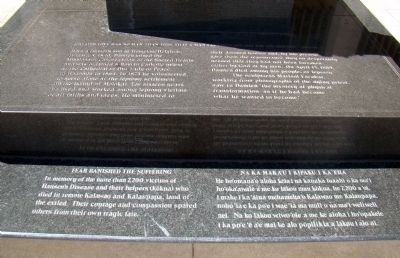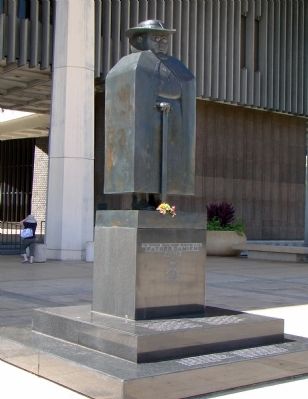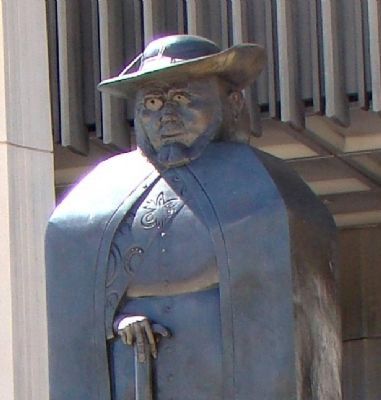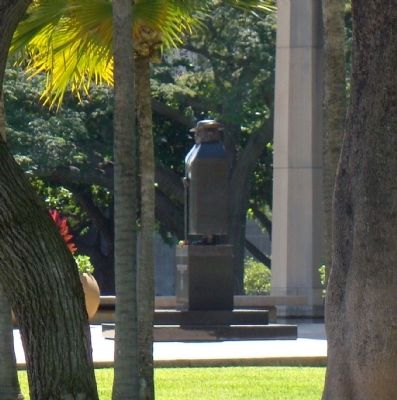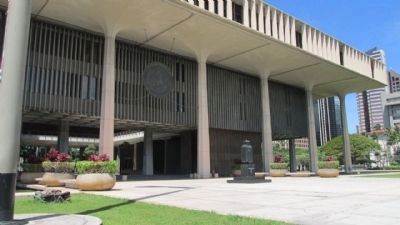Downtown in Honolulu in Honolulu County, Hawaii — Hawaiian Island Archipelago (Pacific Ocean)
Father Damien
The Reverend Joseph Damien De Veuster, SS. CC.
— Hawaii —
Greater love has no man than this, that a man lay down his life for his friends. —John 15:13
Born a farmer’s son at Tremeloo, Belgium, January 3, 1840. Damien joined the Missionary Congregation of the Sacred Heart and was ordained a Roman Catholic priest at the Cathedral of Our Lady of Peace in Honolulu in 1864. In 1873 he volunteered to serve alone at the leprosy settlement on the island of Molokai. For sixteen years he lived and worked among leprosy victims of all faiths and races. He ministered to their doomed bodies and, by his presence gave them the assurance they so desperately needed that they had not been forsaken either by God or by men. On April 14, 1889, Damien died among his people, of leprosy.
The sculptress Marisol Escobar, working from photographs of the dying priest, saw in Damien ‘the mystery of physical transformation—as if he had become what he wanted to become.”
Fear Banished the Suffering. In memory of the more than 7,200 victoms of Hansen’s Disease and their helpers (kōkua) who died in remote Kalawao and Kalaupapa, land of the exiled. Their courage and compassion spared others from their own tragic fate.
Na Ka Maka‘u Kipaku I Ka ‘Eha. He ho‘omana‘o aloha kēla i na kānaka luaahi o ka ma‘i ho‘oka‘awale a me ko lākou mau kōkua, he 7,200 a ‘oi, i make i ka ‘āina mehameha‘o Kalawao me Kalaupapa, noho ‘ia e ka po‘e i wae‘ia ma muli o ua ma‘i weliweli nei. Na ko lākou wiwo‘ole a me ke aloha i ho‘opakele i ka po‘e ‘ē a‘e mai ke alo pōpilikia a lākou i alo ai.
Erected 1968.
Topics. This historical marker is listed in these topic lists: Churches & Religion • Science & Medicine. A significant historical date for this entry is January 3, 1853.
Location. 21° 18.459′ N, 157° 51.417′ W. Marker is in Honolulu, Hawaii, in Honolulu County. It is in Downtown. Marker is on South Beretania Street north of Punchbowl Street, on the left when traveling north. It is in front of the Hawaii State Capitol. Touch for map. Marker is at or near this postal address: 415 S Beretania St, Honolulu HI 96813, United States of America. Touch for directions.
Other nearby markers. At least 8 other markers are within walking distance of this marker. Iolani Palace (about 800 feet away, measured in a direct line); Kawaiaha‘o Landmark (approx. 0.2 miles away); King Kamehameha I (approx. 0.2 miles away); King William Charles Lunalilo (approx. 0.2 miles away); Hiram Bingham (approx. ¼ mile away); a different marker also named Kawaiaha'o Landmark (approx. ¼ mile away); Kawaiaha'o Church (approx. ¼ mile away); Aliiolani Hale (approx. ¼ mile away). Touch for a list and map of all markers in Honolulu.
Also see . . .
Blessed Damien de Veuster. Wikipedia entry. “On May 10, 1873, Father Damien arrived at the secluded settlement at Kalaupapa. Bishop Maigret presented Damien to the colonists as ‘one who will be a father to you, and who loves you so much that he does not hesitate to become one of you; to live and die with you.’ The settlement was bordered by a steep mountain ridge. There were 816 lepers living at Kalaupapa. Damien’s first course of action was to build a church and establish the Parish of Saint Philomena.
“Father Damien’s role was not limited to being a priest. He is said to have dressed ulcers, built homes and beds, built coffins and dug graves.
“It has been stated that the Kingdom of Hawaii didn’t plan the settlement to be in disarray but did not provide sufficient resources and medical help. Damien’s arrival is seen by some as a turning point for the community. Under his leadership, basic laws were enforced, shacks became painted houses, working farms were organized and schools were erected.
“His symbols are a tree and a dove.” (Submitted on November 11, 2008.)
Credits. This page was last revised on February 10, 2023. It was originally submitted on November 10, 2008, by J. J. Prats of Powell, Ohio. This page has been viewed 1,845 times since then and 38 times this year. Photos: 1, 2, 3. submitted on November 10, 2008, by J. J. Prats of Powell, Ohio. 4. submitted on November 11, 2008, by J. J. Prats of Powell, Ohio. 5. submitted on April 27, 2014, by Denise Boose of Tehachapi, California.
